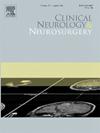运动障碍患者的脊柱畸形手术:在增加并发症和改善长期生活质量之间权衡利弊
IF 1.8
4区 医学
Q3 CLINICAL NEUROLOGY
引用次数: 0
摘要
成人脊柱畸形(ASD)手术后,运动障碍与不良预后相关。在接受ASD手术的患者队列中,我们试图:1)描述运动障碍患者所做的手术,2)比较运动障碍患者与无运动障碍患者在机械并发症、再手术和患者报告的结果测量(PROMs)方面的结果。方法对2009年至2021年接受ASD手术的运动障碍患者进行单机构、回顾性队列研究。纳入标准为:≥ 5级融合,脊柱畸形,随访2年。术后结果包括机械并发症、再手术和prom。根据年龄、性别、BMI和既往手术进行3-1倾向匹配。结果238例接受ASD手术的患者中,有10例(4.2 %)存在运动障碍。5例(50.0 %)患有帕金森病,5例(50.0 %)患有特发性震颤。在有和没有运动障碍的患者之间进行的手术类型,包括总固定水平、三柱截骨和骨盆固定,没有发现显著差异。运动障碍患者发生近端关节后凸和手术失败(PJK/F)的比例更高(80.0 %对40.0 %,p = 0.028),其他机械并发症或再手术的发生率无显著差异。运动障碍患者最好2年海外(20.1 ± 12.5 vs 36.7 ± 14.3,p = 0.015)和NRS-back疼痛比没有运动障碍的患者(2.3 ± 2.5 vs 5.0 ± 2.4,p = 0.022)。结论运动障碍患者与非运动障碍患者的ASD手术相似。尽管PJK/F率高出两倍,但运动障碍患者在术后2年报告的残疾和疼痛情况更好。本文章由计算机程序翻译,如有差异,请以英文原文为准。
Spinal deformity surgery in patients with movement disorders: Trade-off between increased complications and improved long-term quality of life
Introduction
Movement disorders are associated with poor outcomes after adult spinal deformity (ASD) surgery. In a cohort of patients undergoing ASD surgery, we sought to: 1) describe the operations performed in patients with movement disorders, 2) compare outcomes between patients with movement disorders vs. without movement disorders in the areas of mechanical complications, reoperations, and patient-reported outcome measures (PROMs).
Methods
A single-institution, retrospective cohort study was performed for patients with a movement disorder undergoing ASD surgery from 2009 to 2021. Inclusion criteria were: ≥ 5-level fusion, spinal deformity, and 2-year follow-up. Postoperative outcomes included mechanical complications, reoperations, and PROMs. A 3–1 propensity matching was performed, based on age, sex, BMI, and prior surgery.
Results
Among 238 patients undergoing ASD surgery, 10 (4.2 %) had a movement disorder. Five (50.0 %) had Parkinson’s Disease and 5 (50.0 %) had Essential Tremor. No significant difference was found in the type of surgery performed between patients with and without movement disorders, including total instrumented levels, three-column osteotomy, and pelvic instrumentation. Patients with movement disorders developed a higher rate of proximal junctional kyphosis and failure (PJK/F) (80.0 % vs. 40.0 %, p = 0.028) without a significant difference in other mechanical complications or reoperations. Patients with movement disorders had better 2-year ODI (20.1 ± 12.5 vs. 36.7 ± 14.3, p = 0.015) and NRS-back pain than patients without movement disorders (2.3 ± 2.5 vs. 5.0 ± 2.4, p = 0.022).
Conclusion
Patients with and without movement disorders undergo similar ASD operations. Despite a two-fold higher PJK/F rate, movement disorder patients reported better disability and pain at 2-years postoperative.
求助全文
通过发布文献求助,成功后即可免费获取论文全文。
去求助
来源期刊

Clinical Neurology and Neurosurgery
医学-临床神经学
CiteScore
3.70
自引率
5.30%
发文量
358
审稿时长
46 days
期刊介绍:
Clinical Neurology and Neurosurgery is devoted to publishing papers and reports on the clinical aspects of neurology and neurosurgery. It is an international forum for papers of high scientific standard that are of interest to Neurologists and Neurosurgeons world-wide.
 求助内容:
求助内容: 应助结果提醒方式:
应助结果提醒方式:


